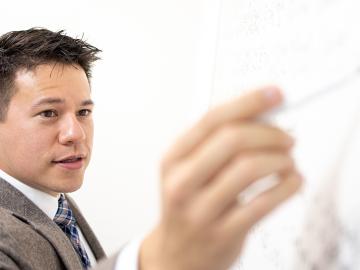ORNL's Communications team works with news media seeking information about the laboratory. Media may use the resources listed below or send questions to news@ornl.gov.
151 - 160 of 310 Results

While some of her earth system modeling colleagues at ORNL face challenges such as processor allocation or debugging code, Verity Salmon prepares for mosquito swarms and the possibility of grizzly bears.

In the Physics Division of the Department of Energy’s Oak Ridge National Laboratory, James (“Mitch”) Allmond conducts experiments and uses theoretical models to advance our understanding of the structure of atomic nuclei, which are made of various combinations of protons and neutrons (nucleons).

As a teenager, Kat Royston had a lot of questions. Then an advanced-placement class in physics convinced her all the answers were out there.

Ilias Belharouak is leading ORNL’s research efforts in investigating new materials for solid-state batteries, which can double the charging capacity of lithium-ion batteries, commonly used today for electronic devices such as cell phones.

Joe Paddison, a Eugene P. Wigner Fellow at the Department of Energy’s Oak Ridge National Laboratory, believes there’s more information to be found in neutron scattering data than scientists like himself might expect.

Nils Stenvig has always had an interest in solving big problems. That desire drove his focus on electrical engineering in college and eventually led him to Oak Ridge National Laboratory, where today he’s using his expertise to better understand the world’s largest machine—the electrical grid.

Valentino (“Tino”) Cooper of the Department of Energy’s Oak Ridge National Laboratory uses theory, modeling and computation to improve fundamental understanding of advanced materials for next-generation energy and information technologies.

As a reactor physics nuclear engineer, Ben Betzler leverages and develops computational methods to solve questions across nuclear energy—whether it’s finding the best design of a reactor core or repurposing an old tool for a new analysis.

Peter Wang is focused on robotics and automation at the Department of Energy’s Manufacturing Demonstration Facility at ORNL, working on high-profile projects such as the MedUSA, a large-scale hybrid additive manufacturing machine.

After several years in the private sector exploring the unknown origins of neurodegenerative brain disorders such as Alzheimer’s, Chris Ellis thinks one of the keys to solving the mystery is at Oak Ridge National Laboratory: the world’s most powerful supercomputer.

